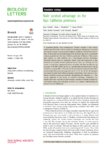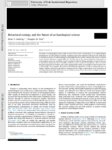Filters: School Or College: "College of Social & Behavioral Science" Collection: "ir_uspace" Type: "Text" Department: "Anthropology"
| Creator | Title | Description | Subject | Date | ||
|---|---|---|---|---|---|---|
| 51 |
 |
Rogers, Alan R. | Migration and genetic drift in human populations | In humans and many other species, mortality is concentrated early in the life cycle, and is low during the ages of dispersal and reproduction. Yet precisely the opposite is assumed by classical population-genetics models of migration and genetic drift. We introduce a model in which population regul... | Frequencies; Variance; Dynamics | 1986 |
| 52 |
 |
Rogers, Alan R.; Jorde, Lynn B. | Ascertainment bias in estimates of average heterozygosity | Population geneticists work with a nonrandom sample of the human genome. Conventional practice ensures that unusually variable loci are most likely to be discovered and thus included in the sample of loci. Consequently, estimates of average heterozygosity are biased upward. In what follows we descri... | Bias (Epidemiology); Biometry; Heterozygote | 1996-05 |
| 53 |
 |
Rogers, Alan R. | Doubts about isonymy | The method of isonymy, developed by Crow and Mange for estimating inbreeding from surname frequencies, requires an assumption that has not been appreciated: It is necessary to assume that all males in some ancestral generation, the founding stock, had unique surnames. Because this assumption is sel... | 1991 | |
| 54 |
 |
O'Rourke, Dennis H. | Patterns of genetic variation in native America | Allele frequencies from seven polymorphic red cell antigen loci (ABO, Rh, MN, S, P, Duffy, and Diego) were examined in 144 Native American populations. Mean genetic distances (Nei's D) and the fixation index FST are approximately equal for the North and South American samples but are reduced in the... | Gene frequencies; Amerinds; Genetic Distance | 1992 |
| 55 |
 |
Rogers, Alan R. | Group selection by selective emigration: the effects of migration and kin structure | Group selection may operate through selective emigration, as Sewall Wright envisioned, as well as through selective extinction. The discrete-generation model of selective emigration developed here yields the following conclusions. 1. The fitness benefit of altruism, "depends on the frequency of altr... | Natural selection; Selective extinction; Evolution | 1990-03 |
| 56 |
 |
O'Rourke, Dennis H. | South from Alaska: a pilot aDNA study of genetic history on the Alaska Peninsula and the Eastern Aleutians | Abstract The Aleutian Islands were colonized, perhaps several times, from the Alaskan mainland. Earlier work documented transitions in the relative frequencies of mtDNA haplogroups over time, but little is known about potential source populations for prehistoric Aleut migrants. As part of a pilot i... | 2010 | |
| 57 |
 |
Rogers, Alan R.; Harpending, Henry C. | Mismatch distributions of mtDNA reveal recent human population expansions | Although many genetic studies of human evolution have tried to make distinctions between the replacement and the multiregional evolution hypotheses, current methods and data have not resolved the issue. However, new advances in nucleotide divergence theory can complement these investigations with a ... | 1994 | |
| 58 |
 |
Rogers, Alan R. | Genetic variation at the MCIR Locus and the time since loss of human body hair | The melanocortin I receptor (MCIR) locus makes a protein that affects the color of skin and hair. At this locus, amino-acid differences are entirely absent among African humans, abundant among non-Africans (especially Europeans), and abundant in chimpanzee/human comparisons (Rana et al. 1999, Hardin... | Nonsynonymous; Chimpanzee; Constraint | 2004 |
| 59 |
 |
Hawkes, Kristen | The derived features of human life history | This chapter compares and contrasts the life histories of extant great apes in order to construct a hypothetical life history of the last common ancestor of all great apes and to identify features of human life history that have been derived during the evolution of our lineage. Data compiled from th... | 2006-01-01 | |
| 60 |
 |
McCullough, John M. | Relatedness and kin-structured migration in a founding population: Plymouth colony, 1620-1633 | To test the common assumption of no genetic relationship in a founding population, we calculated average relatedness (r) for the emigrants to Plymouth Colony from Europe on seven voyages from 1620 to 1633. Of 355 individuals, 255 could be individually identified and 4 generations of genealogic depth... | 1991 | |
| 61 |
 |
Hawkes, Kristen | Alyawara plant use and optimal foraging theory | Various authors have remarked on the importance of seeds in the pre-European diet of central Australian Aborigines. The Alyawara, an Arandic-speaking group, were typical in this respect. They collected edible seeds from nearly half the eighty-five plant species in their traditional subsistence inven... | Australia; Aborigines; Foraging; Seeds | 1981 |
| 62 |
 |
Broughton, John | Prehistoric human impacts on California birds: evidence from the Emeryville Shellmound Avifauna | The abundance of artiodactyls, marine mammals, waterfowl, seabirds, and other animals in 18th- and 19th-century California astonished early explorers, and the incredible wildlife densities reported in their accounts are routinely taken as analogues for the original or pristine zoological condition. ... | Avifauna; Prehistoric hunting; Biological evaluation of environmental impacts | 2004 |
| 63 |
 |
Rogers, Alan R. | Sociobiology of sex and sexes (comment) | A comment on "Sociobiology of sex and sexes" by Marion Blute. | Sociobiology; Sex and sexes | 1984-04 |
| 64 |
 |
Rogers, Alan R. | Evolution of time preference by natural selection | This paper entertains the hypothesis that human time preferences are in evolutionary equilibrium (i.e. that no mutation changing time preferences could be favored by natural selection). This hypothesis implies that the marginal rate of substitution (MRS) holding Darwinian fitness constant must equal... | Capitalism; Econometric models; Equilibrium | 1994-06 |
| 65 |
 |
O'Rourke, Dennis H. | Hrdlič̌ka's Aleutian population-replacement hypothesis: a radiometric evaluation | In a 1945 monograph, Hrdlička argued that, at 1,000 BP, Paleo-Aleut people on Umnak Island were replaced by Neo-Aleut groups moving west along the island chain. His argument was based on cranial measurements of skeletal remains from Chaluka Midden and mummified remains from Kagamil and Ship Rock b... | Population replacement; Paleo-Aleuts; Neo-Aleuts | 2006 |
| 66 |
 |
Macfarlan, Shane | Male Survival Advantage on the Baja California Peninsula | A consistent finding from contemporary Western societies is that women outlive men. However, what is unclear is whether sex differences in survival are constant across varying socio-ecological conditions. We test the universality of the female survival advantage with mortality data from a nineteenth... | ecology; health and disease and epidemiology; behaviour | 2020 |
| 67 |
 |
Cashdan, Elizabeth A. | Waist-to-hip ratio across cultures: trade-offs between androgen- and estrogen-dependent traits | A gynoid pattern of fat distribution, with small waist and large hips (low waist-to-hip ratio, or WHR) holds significant fitness benefits for women: women with a low WHR of about 0.7 are more fecund, are less prone to chronic disease, and (in most cultures) are considered more attractive. Why, then... | Fat distribution; Gynoid pattern; Body types; Waist-to-hip ratio; WHR | 2008 |
| 68 |
 |
Hawkes, Kristen; O'Connell, James F. | Global process and local ecology: how should we explain differences between the Hadza and the !Kung? | In this chapter we discuss explanations for the diversity of behavior of contemporary forager populations. Other contributors document variation among southern African savanna Bushman groups, and central African forest Pygmies. We confine ourselves to trying to explain some differences between two ... | 1996 | |
| 69 |
 |
Wiessner, Pauline W. | On emergency decisions, egalitarianism, and group selection | Boehm (CA 37:763-93) puts forward an important thesis-that with the evolution of egalitarian societies, privileged routes to reproductive advantage are blocked and the power of individua selection severely compromised. With competition so constrained, altruistic behavior can more readily spread i... | Boehm's mode; Evolution of altruistic behavior | 1998-06 |
| 70 |
 |
Broughton, John | Resource intensification and late Holocene human impacts on Pacific coast bird populations: evidence from the Emeryville shellmound avifauna | Anthropologists and conservation biologists have commonly assumed that the distributions and abundances of vertebrate resources recorded during the early historic period in North America reflected a "pristine" condition. This view follows from the perception that Native American population densities... | Resource intensification; Holocene human impacts; Foraging efficiency; Harvest pressure; Bird populations; Emeryville shellmound | 2001 |
| 71 |
 |
Hawkes, Kristen | Binumarien color categories | This paper has two aims. The first is to describe an ethnographically new system of color classification, Binumarien, a non-Austronesian or Papuan language of the Eastern Central Highlands of New Guinea2. In this connection we are particularly interested in relating our data to the Berlin and Kay (1... | Binumarien; Binumariens | 1975 |
| 72 |
 |
Rogers, Alan R. | How much can fossils tell us about regional continuity? | Presents a study on the genetic contribution of earlier populations to later populations within regions called regional continuity. Testing for regional continuity with multiple characters; Replacement of archaic population by a population of modern humans. | Human genetics; Fossils; Regional continuity | 2006-06-05 |
| 73 |
 |
Hawkes, Kristen | Hadza women's time allocation, offspring provisioning, and the evolution of long postmenopausal life spans | Extended provisioning of offspring and long postmenopausal life spans are characteristic of all modern humans but no other primates. These traits may have evolved in tandem. Analysis of relationships between women's time allocation and children's nutritional welfare among the Hadza of northern Tanza... | Child care; Children, nutrition; Life spans, Biology; Mother & child; Primates; Social structure; Women; Time Management; Hominids | 1997 |
| 74 |
 |
Cashdan, Elizabeth A. | Ethnocentrism and xenophobia: a cross-cultural study | Analyzes the factors influencing ethnic affiliation and interethnic hostility. Relationship between intraethnic loyalty and risk of famine; Continuity of violence at different levels of groupings; Analysis of local and intercommunity conflict. | Ethnic relations; Ethnology | 2006-06-06 |
| 75 |
 |
Codding, Brian | Behavioral ecology and the future of archaeological science | The future of archaeological science relies as much (if not more) on theoretical as on methodological developments. As with anything in biology, explaining past human behavior will require the application of evolutionary theory. As with anything in archaeology, theory is useless without clear ties t... | 2015-01-01 |
